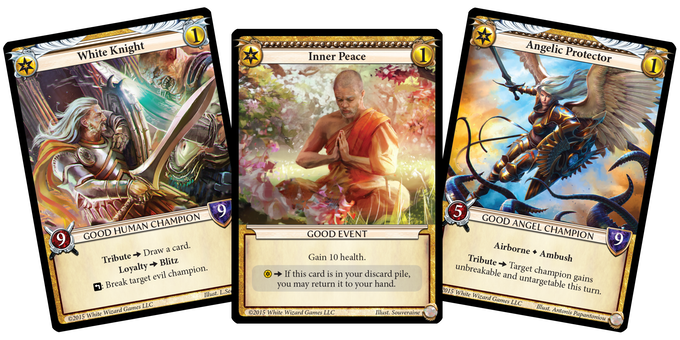
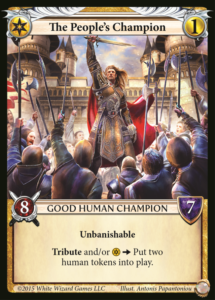
When you combine two types of damage generation (medium and weak), you get a very slow offensive game. This means you have to make up for it with defense. Good has just the means to take care of defense. Let’s break down their actual power bodies, not regarding abilities at all.
- Sum total of Gold Champion Power = 72
- Average of Gold Champion Power = 6*
- Sum of Silver Champion Power = 13
- Average of Silver Champion Power = 2.17
As you can see, with their golds being an average of 6 Power, they aren’t competing very well. Their power sum is 72 total, which reflects their standing against the highest power alignment, Wild (116), which is 62% of the total. Being about 2/3 of the best isn’t very good when you have this much room for gradation. Therefore, Good must (and does) have an alternate solution. Instead, it uses the fact that it can gain a lot of life, block with ambush, play its options close to the chest, and swing over the heads of most blockers in the game. In fact, their average for airborne golds remains the same at 6.
- Sum of Airborne gold power = 36
- Average Airborne gold power = 6
They even have an airborne silver that’s a 5/5. The total non-good gold airbornes is 52 out of 10 cards, which is 5.2 average. This means, the average Good airborne beats the average non-Good airborne by 1 point in damage. So if the two were to just swing over and over, one card from good could kill in 5 turns, while every other color would take almost 6 turns. Reminder, that’s just a control scenario and doesn’t necessarily reflect any given game. This does mean that Good’s entire offensive strategy is to kill in the air.
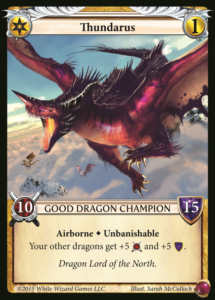
Once there are enough on the field, Good wipes the board and punishes the overextension, swinging in those moments where you start over fresh with very little board presence. As such, spot-removal in Good is actually best used on the opponent’s turn just after a board wipe (or the game start) to keep the opponent’s pace low while you swing with airborne. Or else when the opponent plays an airborne blocker. Or else when you have ambushed an attacker on your opponent’s turn, you can play spot removal on your turn. Any of these three will net you the best possible use of tempo control with spot-removal, and stave off that eventual board wipe while letting you chip some damage.
If Good can hit with 1 flyer per turn (average) for 5 straight turns, they can usually win barring odd scenarios. Generally, this means their defensive strategy is to just stuff a ton of humans onto the ground (or midrange blockers on the ground to stop breakthrough) and spam life replenishment on the opponent’s turns where they aren’t using spot-removal. Inner Peace is a particularly nasty reusable life gain that can sometimes fog an opponent’s entire attacking turn even if you have no blockers. Otherwise though, it can steadily pad out your life for those inevitable turns where the opponent takes the upper hand.
- Sum of Gold defense Champions = 90
- Average of Gold defense Champions = 7.5*
As a percentage of the highest alignment Defense, Good has 73% of Wild’s (123, avg 9.5) defense, which is the highest again in Base Set. This is pretty good when compared to the other alignments which are all below Good, though Sage has 87 total, which is very close to Good’s 90. It’s significantly tankier than Evil but its tokens are much weaker and Evil also uses token walls.
Good really starts to shine with its life gain. As the average damage from the highest (Wild) is 9 per Champion, Good must therefore gain 9 life per turn per champion that it does not block to break even. Cards like Inner Peace and the Righteous-givers really take this to heart. Namely two ridiculous cards that I will cover later can easily make you not only break even but be practically unkillable.
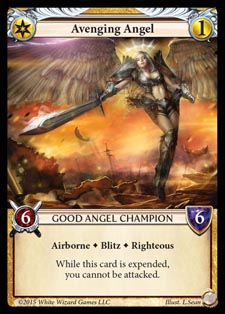
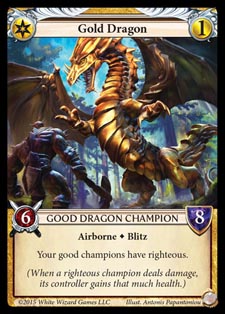
Both of these cards make you invincible while they’re on the field (since Righteous means you gain your Power as life when you damage anything), have the average airborne damage in Good (6) which is 1 higher than the mainstream, both attack immediately, and both swing in the freaking air. It’s actually difficult to say which of the two is more insane. Basically, when either of these cards hit the field, the opponent has to get rid of them immediately or you’re going to dominate the game. These cards will easily win you games. At 6 total copies (in every Good deck), that’s 10% of a constructed deck. If you set up a draw engine with a Noble Unicorn, after your opening turn, it only takes 4 draws to see one of them. Their biggest weakness is hurr-durr “dies to removal” which is basically anything’s weakness.
Honorable mentions: Angel of Mercy and Angel of Light.
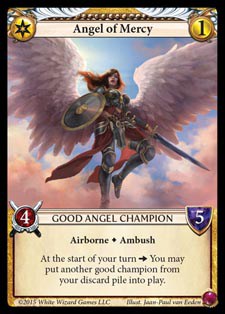
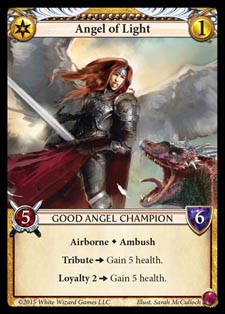
These two are provably less ridiculous champions, however they both have a major advantage over Avenging Angel and Gold Dragon—Ambush, so you can play them on an opponent’s turn, have super-blitz (basically prep them on your first attacking turn), use their abilities one turn earlier, and open up your turn for more options including life gain and spot removal. Angel of Mercy is amazing since it can get back all of the other 3 cards after they inevitably die. Since there’s practically no opportunity cost for not playing her, you have every incentive to hold on to this angel until the perfect moment. Angel of Light is one turn of Inner Peace slapped onto a fast airborne champion. That’s just amazing. Thier Power is all average or below, but since this makes 4 really good airbornes for you (and most decks struggle getting even that many), you’ll definitely have air superiority for the fight. With 10% more added to you deck, you now know that 20% of your deck are going to be some of the best cards in the game and that makes it very easy to draw (about 1 of these four cards in the opening hand).
Are you just griefing me? You’re not even hurting me, this game is just taking forever. ~Some Asshole
However, the good points that Good has are the best. It has arguably the best two champions in the base set and can both protect and resurrect them almost endlessly. Not to mention the scary draw engine it can use to get to these champions. However, two does not a deck make. This is where Good starts running into trouble. Their biggest weakness is actually consistency. Some games, Good “goes off” and does some pretty spectacular stuff, allowing it to compete and often win. Other games, it bricks and continues to brick. By the time you get what you need to fix everything, the game is already lost. Epic doesn’t have time for all this gathering.
Worse still, two of its best four cards are alignment-locked to Good (and Angel of Light is dependent). With very little ability to splash in other alignments that may fix its weaknesses, Good ranks firmly as the lowest of the four pure colors in base set.
Hopefully you all found this an informative and helpful article. If so, be sure to share this with your friends!

Leave a comment